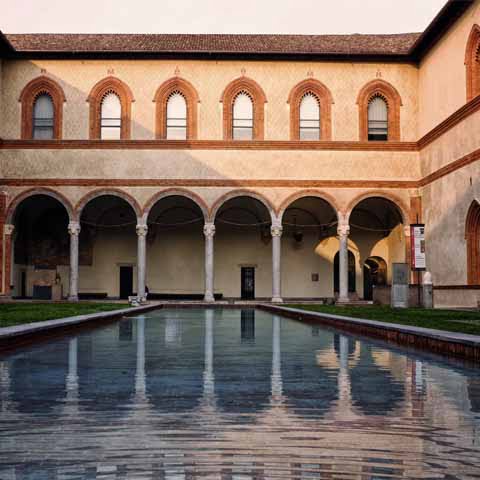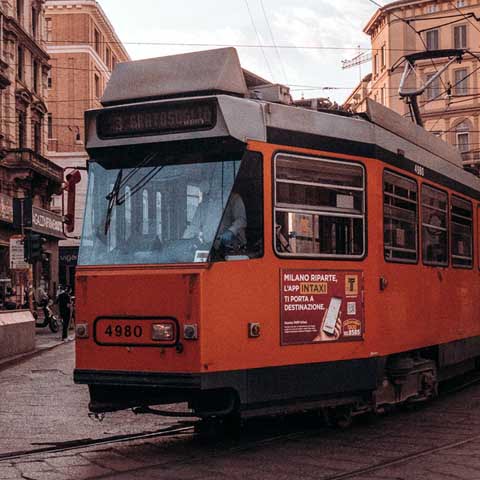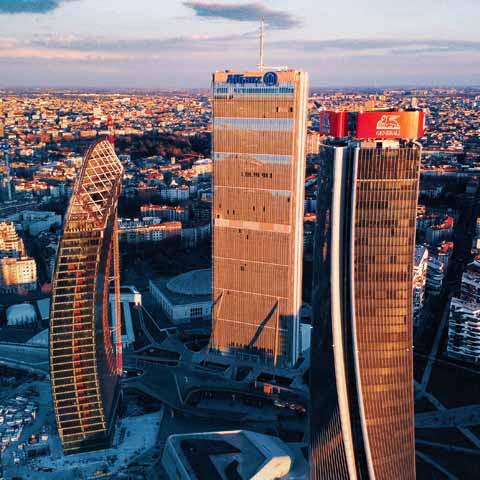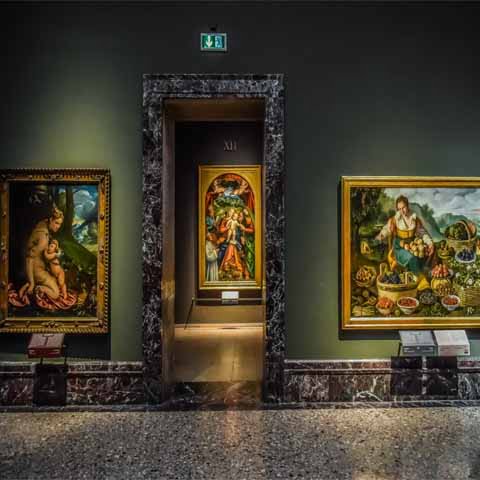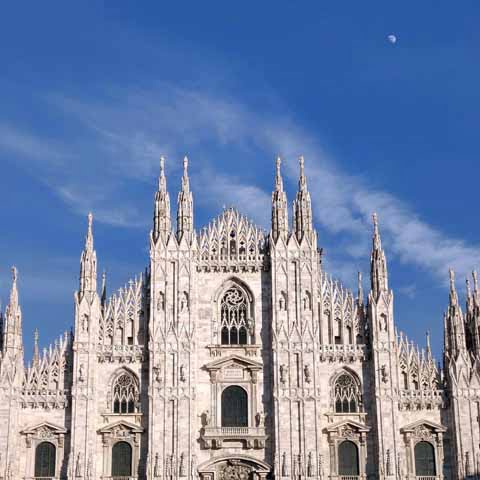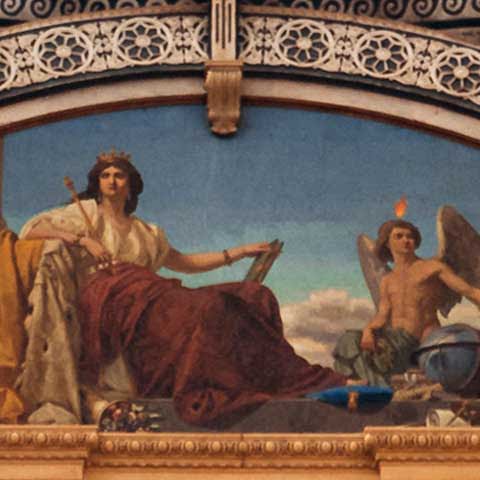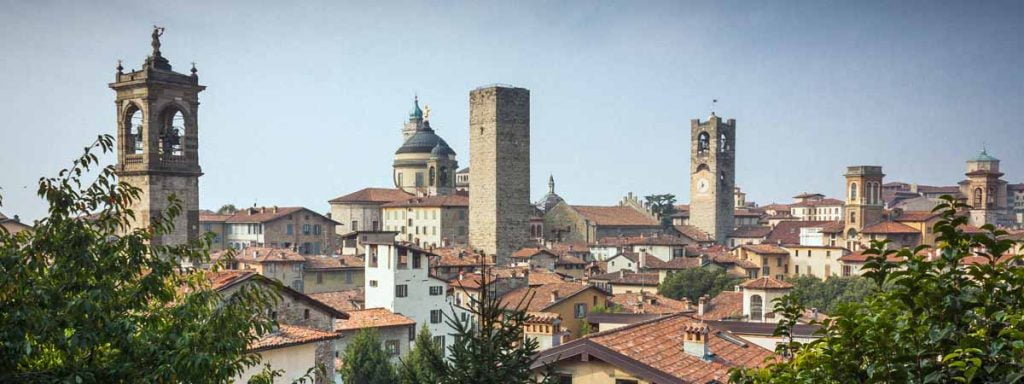While Milan’s fashion scene draws visitors from all over the world, the city has so much more to offer. Travelers of all ages can experience the historic architecture, religious sites, shopping opportunities and fascinating museums of Italy’s second largest city.
FESTIVAL & EVENTS IN MILAN
The Milanese people have the utmost pride in their Northern Italian culture and traditions, which is evident in the city’s various events and celebrations that take place throughout the year.
The most famous event is perhaps Milan’s Fashion Week. While in some cases it actually goes on for longer than a week, this event is held in February and March for spring designs and during September and October for the fall line. Being known as the world’s “fashion capital,” it comes as no surprise that Milan attracts an abundance of royalty, celebrities, and fashion icons during the event. Tickets can be scarce, but many visitors and locals alike gather for the chance to catch a glimpse of the who’s who of fashion. Event staff place giant screens around the area with live broadcasts of the catwalk action.
On December 7, the Festival of Sant’Ambrogio, takes place to honor Milan’s patron saint, Saint Ambrose. As part of the celebrations, the fair known as “Oh bej Oh bej!“, can be found up and down the streets around the Castello Sforzesco in the city center from December 7 up until the following Sunday. Visitors are able to shop the many stalls of vendors selling handcrafted items, collectibles, and food items. Roasted chestnuts are a popular treat at the festival.
Also, in December, the city hosts Artigiano in Fiera, which is one of the largest artisan fairs in the world. The fair is essentially an enormous marketplace where artisans from all over the world can sell their products. It is often possible to watch the artisans as they create their products during special exhibitions.
For those interested in experiencing the country’s love for jazz music, the Milan Jazz Festival commences during the first week of November and typically lasts at least two weeks. Clubs and other venues, both indoors and out, host performances by well-known jazz musicians from throughout Italy and Europe. In addition to enjoying various jazz styles, travelers can also attend musician meet-and-greets and informative workshops.
Other popular events that take place in Milan include:
• The Corteo dei Re Magi Procession – January 6. Held on the Feast of the Epiphany, the procession is a commemoration of the arrival of the Three Wise Men. The procession begins in Piazza Duomo and features Three Wise Men who lead the crowd to the Basilica of Sant’Eustorgio. Upon arrival, the Wise Men offer gifts to local children.
• Milano Film Festival – during September. This is a celebration of international films and short films. The festival takes place in various venues throughout the city such as Parco Sempione, the Civic Aquarium, and Spazio Oberdan.
• Italian F1 Grand Prix – early September. Held in the Autodromo Nazionale in the nearby city of Monza, this is the most important annual Formula 1 race in Italy and one of the oldest national Grands Prix in the world.
• The Tredesin de Mars Festival – March 13. Associated with the beginning of spring, the event features a flower fair and commemorates when Catholicism became Milan’s primary religion.
• The Food and Wine festival – Milano Golosa – October. This is a gastronomy festival dedicated to the best Italian flavors. The event features three days of cooking shows and workshops with thousands of local product tastings.
• Milano Pride Week – June. This weeklong festival features events related to the LGBTQ+ community culminating with a parade. Milano Pride Week is one of the largest events of its kind in Italy.
• Salone Macchine e Attrezzature per l’Ufficio (SMAU) – October. This international trade fair focuses on information and communication technology. Held in Fieramilanocity, the site of Milan’s most important trade fairs, the event showcases the year’s important technological innovations and provides a forum for discussion as well as implementation.
• Salone Internazionale del Mobile – April. This is the largest furniture trade fair in the world showcasing the best of international furniture design.
• La Prima della Scala Opera House – December 7. Opening night of the new season at Teatro alla Scala is a big event. As one of the most important nights on the Milanese calendar, opening night has coincided with the Feast of Saint Ambrose since 1951.
OUTDOOR ACTIVITIES
Exploring the capital city of Lombardy would not be complete without enjoying all it has to offer outdoors. To live Milan like the locals, visitors can rent bikes and ride one of the scenic trails running in and around Milan. The Naviglio Grande and Naviglio Martesana trails extend from the city center to the countryside along Milan’s canals, with the latter trail reaching the Adda River. The nearly flat terrain makes exploring by bike an ideal option.
Traveling by boat along Milan’s historic canals is another way to see the sights and culture that remain in the city today. The canal system was developed during the Middle Ages to aid transport in and around the city. A total of five canals were built, three of which were interconnected. In the first half of the twentieth century, several of the canals were covered and commercial transport along the canals slowed. The canals are mainly used for irrigation now, however some of the canals have been revitalized. Milan’s ancient port, the Darsena, sits at the intersection of the well-known Naviglio Grande and Naviglio Pavese and has become a center of the city’s nightlife. During the day, travelers can enjoy boat tours along the Naviglio Grande and Naviglio Pavese canals to admire views of the small shops, art galleries, restaurants and bars that line the water.
While exploring Milan, travelers will find a number of fascinating outdoor sites, from historic monuments to modern art, spread throughout the city.
Beginning with the historic sites, the enormous Arco della Pace, or Arch of Peace, located in Parco Sempione, has served as a gathering place for Milanese for centuries. The Neoclassical arch decorated with beautiful bas-reliefs stands on the site of a former entrance to the city that was part of the Roman walls. The current structure was commissioned in 1807 while Milan was under the rule of Napoleon, and it was designed to mark the beginning of the road that connects Milan to Paris via the Passo del Sempione (Simplon Pass). Completed in 1838, the arch is an important symbol of the city’s history as it marked the escape route of the retreating Austrian army led by Josef Radetzky in 1848 following the Five Days of Milan Rebellion.
Milan’s Cimitero Monumentale (Monumental Cemetery) is so much more than a cemetery. In addition to hosting the graves of some of the city’s most illustrious citizens, such as Alessandro Manzoni and the Campari Family, the majority of the tombs are richly decorated with stately sculptures, resulting in a true open-air sculpture museum. A nice stroll through the cemetery to admire the sculptures and the Famedio, an enormous Neo-Gothic mausoleum, is the perfect way to spend an afternoon in Milan.
Casa Galimberti, which was designed by architect Giovanni Bossi between 1903 and 1905, is considered to be one of the most beautiful buildings of Milan’s Liberty or Art Nouveau period. The majority of the building’s façade is embellished with stunning majolica tiles, elegant braided wrought iron, and refined floral motifs.
Of course, evidence of Milan’s past as a Roman city can be admired as well. The best example is the Colonne di San Lorenzo, or San Lorenzo Columns. Composed of sixteen marble columns, these remarkable ruins are positioned in front of the Basilica of San Lorenzo Maggiore and serve as a social hub, both during the day and at night.
Among the most iconic modern pieces is the L.O.V.E. sculpture created by Maurizio Cattelan in 2010, which has been nicknamed “The Finger” by the locals. Positioned in front of the city’s stock exchange in Palazzo Mezzanotte, the statue depicting a hand with one outstretched finger sends a clear message to the city’s financial world. The title of the work stands for Libertà, Odio, Vendetta, Eternità, which means Freedom, Hate, Vengeance, Eternity. Originally designed to be a temporary installation, the decision was made to keep the statue indefinitely.
Continuing with the city’s modern installations, Ago, filo e nodo (Needle, Thread and knot) is a sculpture by artists Claes Oldenburg and Coosje Van Bruggen that was installed in 2000. It is situated in Piazzale Cadorna in front of the Milan Cadorna railway station and subway station, one of the city’s main transportation hubs. The sculpture, which depicts a large needle and colorful thread represents the city’s industriousness and role as a fashion capital. The thread passing through the eye of the needle is said to serve as a metaphor for a train passing through a tunnel, while the colors of the thread – red, green, and yellow – represent the city’s three original subway lines.
Moving over to CityLife, one of Milan’s newest and innovative neighborhoods, art lovers should consider visiting ArtLine Milano. This open-air civic art project provides a cultural itinerary exhibiting over twenty permanent works by artists under 40. The CityLife district is worth a visit also for its three iconic skyscrapers designed by international architects Zaha Hadid, Daniel Libeskind, and Arata Isozaki that tower over the skyline.
Disco Grande is a bronze sculpture designed by artist Arnaldo Pomodoro in 1972. Showcasing Pomodoro’s distinct style, the sculpture depicts a shimmering golden disc composed of curved and straight lines and a multitude of geometric shapes fused together to create the interior. The sculpture is currently located in Milan’s Piazza Meda, between Piazza Duomo and the Quadrilatero della Moda (the fashion district).
Approximately 30 miles to the north of Milan, Lake Como offers spectacular, panoramic views of the crystal blue water and nearby mountains. Shaped like an upside-down letter Y, the lake is surrounded by charming towns such as Bellagio and Varenna. The area is a popular travel destination with its lakeshore promenades, upscale dining and shopping areas, hiking trails, water sports, and ornate villas with elaborate gardens.
INDOOR ACTIVITIES
In addition to Milan’s stunning outdoor sites, there are plenty of monuments with interiors more than worthy of a visit. The city is extremely rich in treasures waiting to be discovered, as well as churches and museums that will satisfy art and history enthusiasts.
First and foremost is the Gothic Duomo Cathedral, which represents the heart of Milan. As the largest cathedral in Italy and one of the most beautiful Gothic churches in the world with its stunning marble and golden Madonnina statue, the Duomo manages to enchant each of Milan’s visitors, young and old. Upon admiring the seemingly endless spires and statues with their elaborate decorations, it is easy to understand how the construction, which began in the fourteenth century, was not officially completed until nearly six centuries later (with renovation and restoration works that are likely to continue indefinitely). Commissioned by Gian Galeazzo Visconti, Duke of Milan, the Duomo has become the city’s most important symbol and holds a very special place in the heart of every Milanese. For a special view of the city, head to the rooftop terraces to admire panoramas of Milan and the surrounding mountains.
As one of the most iconic works of art in the world, Leonardo Da Vinci’s Last Supper is a fitting symbol of Milan’s artistic heritage. Located in the Dominican convent of Santa Maria delle Grazie in the center of Milan, the fresco was commissioned by Ludovico il Moro, Duke of Milan, in celebration of the family church of the House of Sforza. A masterwork in the study of perspective, Leonardo expertly portrays the movements and expressions of Christ and his disciples. Due to the fragile state of the work, the Last Supper is displayed in a climate-controlled room and visits, which must be booked well in advance, last only 15 minutes. Nevertheless, admiring the beauty of the Last Supper is one of Milan’s unique experiences that should not be missed.
A short walk from the Duomo, Milan’s Teatro alla Scala is the most famous opera house in the world and a must-see destination for lovers of music and culture. All of history’s most important opera singers, conductors, ballet dancers, and directors, such as Bellini, Verdi, Maria Callas, Luciano Pavarotti, Carla Fracci, and Luchino Visconti, have graced La Scala’s elegant stage. Constructed from 1776 to 1778, Teatro alla Scala quickly became one of the world’s most renowned theaters. Attending an opera or ballet performance at Teatro alla Scala is a once-in-a-lifetime experience performing arts devotees will greatly treasure. Outside of the performances, travelers should consider visiting the opera house’s museum, which provides a fascinating look at La Scala’s rich history.
Representing a fascinating part of Milan’s history, the Castello Sforzesco is one of the largest castles in Europe. Over the centuries the castle has served as a fortress, residence of the Duke of Milan, and military barracks. After extensive renovations, today the castle hosts several important civic museums including the Museum of Ancient Art and a Pinacoteca (art gallery) with works by Andrea Mantegna, Giovanni Bellini, and more. Even without visiting the museums, the expansive courtyards, large walls, and historic towers present on the castle grounds are truly fascinating. Adjacent to the castle is the lush greenery of Parco Sempione, the largest park in Milan’s city center, and the perfect place to unwind after a day of sightseeing.
One of the oldest churches in the city is the Basilica of San Lorenzo Maggiore. It was first built during the fourth and fifth centuries, yet it saw its share of devastation in the centuries to follow. Destructive fires and earthquakes hit during the eleventh and twelfth centuries and the dome collapsed in 1573 – leading to a number of restorations in its history. The church continues to be a representation of the Roman Empire’s legacy with the bronze statue of Emperor Constantine, paying homage to the end of Christian persecution – front and center in the courtyard – as well as the Ancient Roman columns, the San Lorenzo Columns, present in front of the church. On the inside, detailed Byzantine mosaics can be seen on the walls above areas of marble on the lower portions. Additional chapels are connected to the main building, including the Chapel of Sant’Aquilino – originally built as a mausoleum.
For art enthusiasts, the Pinacoteca di Brera is a perfect option. As the most important art gallery in the city, it provides visitors with the chance to view one of the largest collections of Italian art. Most of the paintings in its inventory were brought there during Napoleonic times from monasteries and churches. Featured artists include Rembrandt, Goya, Caravaggio, and Van Dyck. Raphael’s Betrothal of the Virgin and Andrea Mantegna’s Lamentation of Christ are just two amazing pieces among the many famous masterpieces.
Another must-see art gallery is the Pinacoteca Ambrosiana, which is located in the Ambrosian Library. The works of three master Italian artists are on display here, among others, including an important collection of Leonardo’s drawings and writings known as the Codex Atlanticus, Caravaggio’s Basket of Fruit, and Raphael’s full-scale draft of the School of Athens, the masterpiece of the Vatican’s Raphael Rooms.
Lovers of modern art should make a point to visit the Museo del Novecento, a museum located in Piazza Duomo that is dedicated to twentieth century art. The collection, with approximately 400 works, features art by the likes of Kandinsky, Amadeo Modigliani, Paul Klee, and Alberto Burri. In addition to the art, the building that hosts the museum is quite innovative with an upper floor gallery that offers remarkable views of the Duomo.
Besides the Duomo, there are several other fascinating churches in Milan. One is an ancient church founded by Saint Ambrose himself during the fourth century called the Basilica of San Nazaro in Brolo, which is positioned on the road that stretches from Milan to Rome. The origins of the church are even older than the current structure, and as a result the site is an excellent example of Paleo-Christian art.
When in Milan, travelers must stop by the church dedicated to the city’s beloved patron saint, the Basilica of Sant’Ambrogio. The beautiful Romanesque church has been a key pilgrimage destination for centuries. Originally built towards the end of the fourth century, the structure was eventually rebuilt in the Romanesque style. One must-see inside the church is the Golden Altar, which dates back to the ninth century and depicts scenes from Christ’s life as well as the life of Saint Ambrose. Below the altar of the church rest the remains of martyrs Gervasius and Protasius as well as Saint Ambrose himself.
SHOPPING
A trip to Milan would not be complete without experiencing shopping throughout the “fashion capital.” With such a focus on the fashion and design industry, the city is a major destination for visitors on any budget. There are shops representing high end names, unique family-owned boutiques, and large department stores to choose from.
The Quadrilatero d’Oro, or the “Golden Rectangle,” also called Quadrilatero della Moda, or the “Fashion Rectangle,” is a four-street district (consisting of Via Monte Napoleone, Via Manzoni, Via della Spiga, and Corso Venezia), offering well known, chic fashion from such brands as Versace, Prada, Armani and many more.
For further shopping, visit the historic Galleria Vittorio Emanuele II. Constructed in 1865, the dual arcade is the oldest standing mall in the world and continues to draw shoppers as well as architecture buffs to admire the Latin cross lay-out and marble, mosaic floors. The gallery offers high fashion names along with locally owned shops, restaurants, and cafés.
Other shopping opportunities include major department stores near the Duomo, the whimsical boutiques in the Brera district, the flea markets in the Navigli District, and other shopping streets such as Corso Buenos Aires and Via Torino.
A newer area to visit is the CityLife Shopping District, which is surrounded by the city’s second largest park and features the three iconic skyscrapers: Allianz Tower, Generali Tower, and Libeskind Tower.
FAMILY & KIDS
Milan is sure to provide lasting memories to those visiting as a family. Travelers of all ages will enjoy exploring what the city has to offer. A great starting point is one of its many parks and gardens, where youngsters can have space to run and parents can enjoy the surrounding beauty. Giardini di Villa Reale is an English-style garden that is perfect for picnics or watching the koi fish in the lake. Constructed at the end of the eighteenth century, Villa Reale is an excellent example of Neoclassicism and is renowned for its beautiful façades.
Montanelli Gardens can be found in the northeast part of Milan’s city center. The park includes a planetarium and Natural History Museum. In fact, the Planetario di Milan is the largest and oldest planetarium in Italy. It offers plenty of opportunities for young travelers and their families to learn more about the night sky.
On the northwest side of the city center is the largest recreation spot – Parco Sempione or Sempione Park. In addition to walking through the beautiful green space and admiring the Arch of Peace, visitors can enjoy an aquarium, a Japanese garden, and a city library.
Families can enjoy exploring the exhibits at the Leonardo da Vinci Museum of Science and Technology. The largest of its kind in Europe, this technical museum is focused on the progress of science, starting with the inventions of Leonardo da Vinci. Geared towards kids, but providing plenty of interesting exhibits to keep parents entertained as well, visitors can interact with models created based on the artist’s drawings and manuscripts including cannons, helicopters, and weaving machines. A moon rock collected on the last Apollo mission and the S-506 Enrico Toti submarine are among the displays that should not be missed.
Other worthwhile options for family fun include the Flight Museum (called Volandia, which is located approximately 30 miles from Milan), the Museum of Cultures, and the Civic Aquarium of Milan.
UNIQUE EXPERIENCES IN MILAN
Beyond the fashion and historic architecture, Milan has opportunities for one-of-a-kind experiences. At the top of the list is San Bernadino alla Ossa – a church located near the Duomo di Milano. What makes the building unusual are the endless human bones and skulls that adorn the interior walls of a small side chapel. Legend has it that the neighboring cemetery was full, resulting in the construction of the chapel to store the bones following the deaths of plague victims and prison inmates.
Sports fans can head to the Giuseppe Meazza stadium, also known as San Siro – the largest arena in the country. Holding nearly 80,000 people, the stadium is home to Milan’s two soccer clubs – A.C. Milan and Inter Milan. The arena also offers the country’s first Sports Museum, where visitors can view over 3,000 pieces of historical sports paraphernalia. Throughout the year, the stadium hosts other events such as Milan’s biggest concerts. Additionally, the stadium is set to host the opening ceremony of the 2026 Winter Olympics that will be held in Milan and Cortina d’Ampezzo.
With its rich history, elegant atmosphere, and endless treasures, Milan certainly holds its own against Italy’s other major art cities. As an ancient city with a modern feel, Milan will become more and more interesting with each passing year thanks to its constant innovation in the fields of architecture, art, fashion, and design.
Don't just see Italy, live it.
Your dream trip to Italy has never been closer
No more endlessly scrolling travel sites. Our travel experts will craft the perfect, one-of-a-kind trip just for you.

300+
DESTINATIONS
We offer more Italian destinations than any travel site. Do and see more with Trips 2 Italy.
1 (of a kind)
ITINERARIES
Because your dream trip to Italy should be designed for you, not for the masses.
100%
PEACE OF MIND
From flights and accommodations, to food and activities - we take care of every detail.
